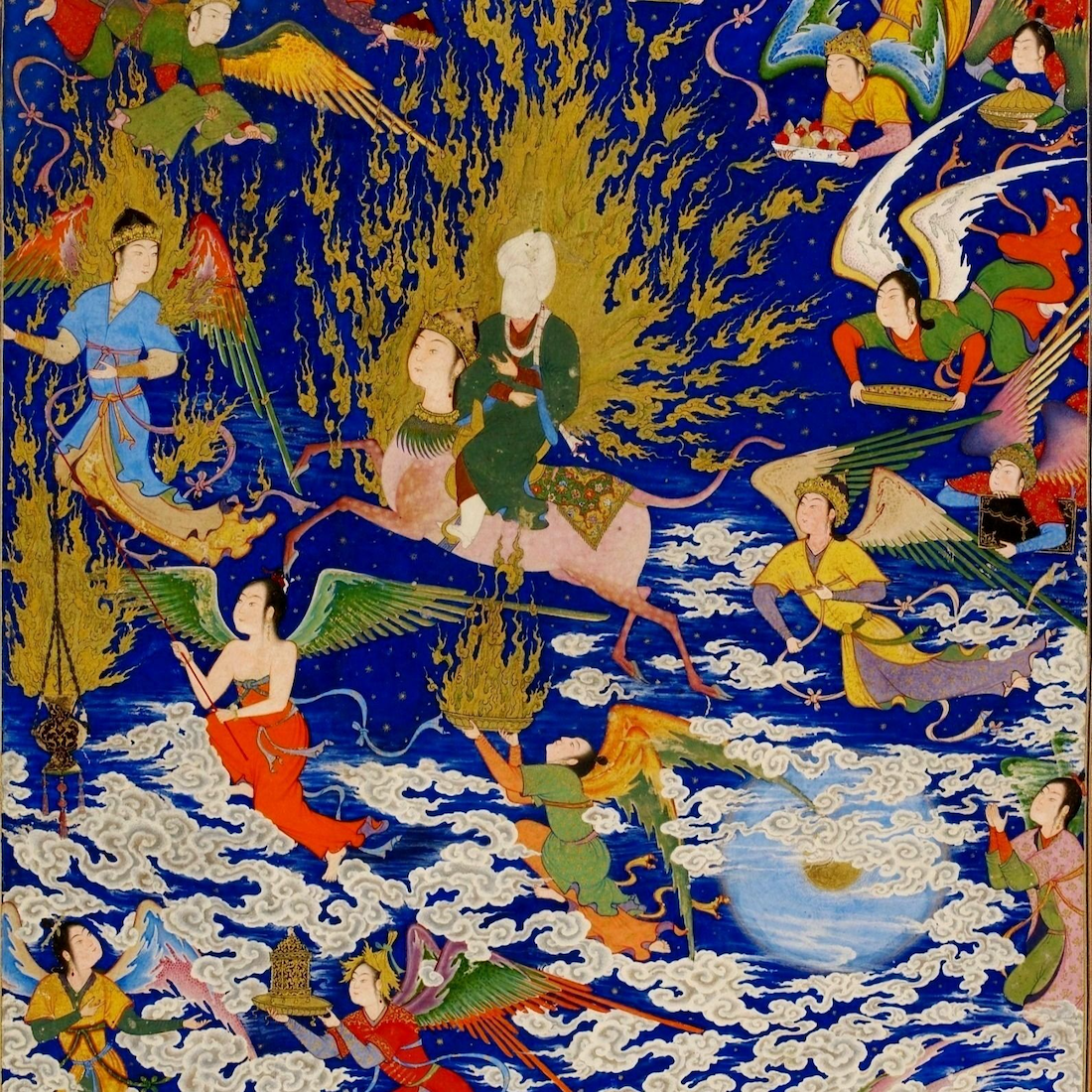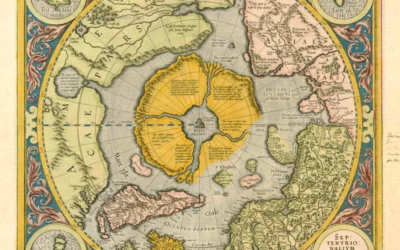1. Who was Ibn ‘Arabi?
Ibn ‘Arabi (1165-1240), the great Andalusian Sufi mystic and philosopher, is widely regarded as one of the most profound and influential figures in Islamic spirituality. Considered by some to be the greatest of all Muslim philosophers, his vast corpus of writings offers an unparalleled exploration of the nature of reality, the human soul, and the path to spiritual realization. At the heart of Ibn ‘Arabi’s thought is a vision of the unity and interdependence of all existence, a perspective that resonates deeply with the perennial philosophy and the insights of depth psychology. This essay will examine the key themes and concepts in Ibn ‘Arabi’s metaphysics, including his doctrine of wahdat al-wujud (the unity of being), his understanding of the human being as al-insan al-kamil (the perfect human), his ontology of imagination and the imaginal world (alam al-mithal), and the Sufi path of ascent to the Divine. It will explore the relevance of these ideas for the perennial philosophy and the contemporary understanding of the psyche and the process of individuation.
2 The Unity of Being (Wahdat al-Wujud)
2.1 The Doctrine of Unity
The central concept in Ibn ‘Arabi’s metaphysics is wahdat al-wujud, the unity or oneness of being. According to this doctrine, all of existence is a manifestation of the one divine reality, which he calls al-Haqq (the Truth) or al-Wujud (Being). This absolute reality is the source and ground of all that exists, and is present in every aspect of creation. The multiplicity and diversity of the phenomenal world is not an illusion or a veil, but a theophany, a revelation of the divine names and attributes. Each being is a unique expression of the divine reality, with its own “face” reflecting the divine qualities. As Ibn ‘Arabi writes, “The cosmos is all letters, words, chapters, and verses, so it is the Great Koran.”
2.2 Transcendence and Immanence
While affirming the absolute unity of being, Ibn ‘Arabi also maintains the fundamental distinction between the divine essence (dhat) and the divine names and attributes. The essence is the Nondelimited (mutlaq), beyond all definitions and relations, while the names are the relationships or relational forms that allow the Absolute to be manifest in creation. The divine names are uncountable, as they include not only the traditional 99 names mentioned in Islamic sources, but all possible relationships between God and the world. Each being is a self-disclosure (tajalli) of specific divine names.
Ibn ‘Arabi resolves the paradox of divine transcendence and immanence through his concept of the barzakh or isthmus. The barzakh is the imaginal realm that both separates and joins the absolute and the relative, the infinite and the finite. Every created thing is a barzakh between being and non-being, a “place of manifestation” (mazhar) for the divine names. The cosmos as a whole is the “Perfect Man” (al-insan al-kamil) or the Universal Barzakh that brings together all the divine names in a single, comprehensive form.
2.3 Implications for the Perennial Philosophy and Depth Psychology
Ibn ‘Arabi’s doctrine of wahdat al-wujud has profound implications for the perennial philosophy, which holds that a common core of spiritual truth underlies the world’s religious traditions. The recognition of the unity of being and the divine reality pervading all things is the universal truth that transcends any single tradition. This perspective opens the door to an integral approach to spirituality based on the direct apprehension of the sacred within all dimensions of existence.
For depth psychology, the idea of wahdat al-wujud suggests an underlying wholeness and integration of the psyche, which includes both conscious and unconscious elements. The process of individuation, in which the individual becomes more conscious of the deeper layers of the psyche, can be seen as a movement towards realizing the essential oneness of the Self (the psychological equivalent of the divine reality). This unitive vision also provides a framework for understanding the symbolic and archetypal dimensions of the psyche as expressions of a universal, transpersonal reality.
3 The Perfect Human (Al-Insan al-Kamil)
3.1 The Human Being as Microcosm
Another key theme in Ibn ‘Arabi’s thought is his concept of the human being as al-insan al-kamil, the “perfect human” or “universal human.” For Ibn ‘Arabi, the human being is a microcosm, reflecting and containing within itself all the divine names and attributes present in the macrocosm. The human was created in the image of the divine, as attested by the sacred tradition “God created Adam in His form.” More specifically, the human being was created in the form of the name Allah, which is the all-comprehensive name that brings together all the divine names. The human soul (ruh) is the barzakh or isthmus between pure Spirit and the manifest world, participating in all the levels of reality.
The “perfect human,” then, is the one who has fully actualized the divine potential within, integrating and embodying the divine attributes in the most complete and balanced way possible. The prophets and saints are the preeminent examples of human perfection, but this state is the birthright and ultimate destiny of every human soul. The path to perfection is one of theomorphism (tashbih) and deification (ta’alluh), becoming an ever more polished mirror for the divine names.
3.2 Human Perfection and the Sufi Path
For Ibn ‘Arabi, the Sufi path of spiritual realization is synonymous with the process of becoming the perfect human (insan kamil). In his major work al-Futuhat al-Makkiyya (The Meccan Revelations), he describes the stages of this path as a series of ascending “waypoints” or “manzils” that unveil increasingly profound levels of insight and union with the divine. The journey culminates in the state of “no waypoint” (manzil la manzil), in which the mystic transcends all limited spiritual states and stations while integrating them all in a supreme realization of divine oneness.
At this ultimate stage, the perfect human being becomes the isthmus (barzakh) between the absolute and the relative, fully participating in both divine transcendence and immanence. Ibn ‘Arabi speaks of this state as the Muhammadan Reality (al-haqiqa al-muhammadiyya), the primordial logos or archetypal reality of the Prophet Muhammad and all other prophets. The Muhammadan Reality is the intermediary between the divine Essence and the world, the means by which God knows and creates the universe. The perfect human, as a manifestation of this reality, is the channel of divine grace and the preserver of the universe.
3.3 Implications for the Perennial Philosophy and Depth Psychology
Ibn ‘Arabi’s vision of the perfect human has far-reaching implications for the perennial philosophy’s understanding of human nature and potential. It suggests that the realization of our divine nature is a universal possibility, transcending particular religious and cultural forms. At the same time, Ibn ‘Arabi’s emphasis on the prophets and saints as models of perfection points to the importance of revealed traditions and spiritual lineages as frameworks for guidance and transformation.
From the perspective of depth psychology, the idea of the perfect human can be seen as a symbol of the process of individuation and Self-realization. The Self, in Jung’s terms, is the archetype of wholeness and the regulating center of the psyche, guiding the process of integrating the conscious and unconscious dimensions of the personality. Ibn ‘Arabi’s depiction of the journey to human perfection through ascending stages of insight and realization parallels the process of psychological development and the unfolding of the Self. The figures of the prophets and saints, meanwhile, can be understood as archetypal images of the individuated or fully realized human being.
4. Imagination and the Imaginal World (Alam al-Mithal)
4.1 The Ontology of Imagination
A central component of Ibn ‘Arabi’s worldview is his cosmology of imagination (khayal) and the imaginal world (alam al-mithal). For Ibn ‘Arabi, imagination is not just a human faculty, but an objective, ontological reality that pervades all levels of existence. The entire cosmos is an “imaginal realm” (barzakh) that brings together and mediates between the absolute and the limited, the unseen and the manifest, the spiritual and the corporeal. Every created thing is both real and unreal, a “dream” or an “illusion” that has no independent existence but is nevertheless an authentic self-disclosure of the Real.
Within this universal imaginal realm, there is a specific ontological level that Ibn ‘Arabi calls the alam al-mithal, the world of symbols and imagination. This is the world where spiritual realities take on sensible forms, and where sensible objects are spiritualized. It is an intermediary world “where spirits are corporealized and bodies spiritualized,” standing between the physical world of the senses and the spiritual world of abstract meanings. The imaginal world is the realm of revelatory visions, prophetic dreams, mystical encounters, and eschatological events, where the divine qualities are directly perceived in their archetypal forms.
4.2 Imagination and Spiritual Practice
For Ibn ‘Arabi, the spiritual path necessarily involves the cultivation of the imaginal faculty and learning to navigate the imaginal world. The heart (qalb), the organ of spiritual perception, is intimately connected with the imagination. It is through the heart’s imaginal perception that the divine revelations, both outward and inward, are received and interpreted. The practice of spiritual recollection (dhikr) and meditation (muraqaba) polishes the heart’s mirror, enabling it to reflect the divine realities more perfectly.
In his discussions of the Prophet Muhammad’s heavenly ascent (mi’raj), Ibn ‘Arabi describes the voyage of realization as a journey through ascending imaginal realms, each associated with a prophet and a particular divine name. These levels represent the transformation of the soul as it integrates and assimilates the qualities of each “waypoint,” culminating in the station of “no station” beyond all limitations. The heart becomes the “Throne of the All-Merciful,” embracing all of creation as a perfect mirror of the divine names.
4.3 Implications for the Perennial Philosophy and Depth Psychology
Ibn ‘Arabi’s doctrine of the imaginal has important implications for the perennial understanding of spirituality and its relationship to the symbolic dimension of existence. It highlights the significance of mythic, symbolic, and imagistic modes of cognition alongside the rational and conceptual. The perennial insight that there is a hierarchical spectrum of reality-levels, spanning from the material to the divine, is here specifically articulated in terms of the imaginal realm as the isthmic link between the physical and spiritual worlds.
From a depth psychological perspective, Ibn ‘Arabi’s imaginal world can be fruitfully compared to Jung’s concept of the collective unconscious, the universal, transpersonal dimension of the psyche that is structured by archetypes. The archetypes are dynamic, symbolic patterns that underlie and guide the psyche’s unfolding, and manifest in dreams, visions, and myths. Just as Ibn ‘Arabi sees the spiritual path as involving the progressive integration and realization of spiritual archetypes (the divine names), so depth psychology sees individuation as the conscious assimilation of archetypal potentials. The techniques of active imagination and dream work in particular can be seen as analogous to Ibn ‘Arabi’s emphasis on cultivating imaginal perception.
5. Unity and Diversity in Ibn ‘Arabi’s
Thought While the overarching theme of Ibn ‘Arabi’s philosophy is the oneness and unity of being, he consistently emphasizes that this unity expresses itself through the diversity and multiplicity of creation. The divine names, although they are all non-existent in relation to the Essence, have distinct relationships and qualities that become manifest in specific ways in each creature. Each being reflects the Real in its own unique manner, so that the universe in its infinite variety may be said to be “ever-new” (jadid) at each instant.
In the human realm, this principle of “unity in diversity” is reflected in Ibn ‘Arabi’s attitude towards the different religious traditions and spiritual paths. Although he is firmly rooted in the Islamic tradition, he regards all authentic religions as valid paths to the Real, based on the Quranic verse “Wheresoever you turn, there is the face of God.” Each revelation expresses the divine truth in a manner adapted to the spiritual needs and aptitudes of its recipients. At the same time, Ibn ‘Arabi does not advocate a facile universalism that would disregard the differences between traditions. He maintains that Islam is the most complete and universal revelation, the essence of which is the doctrine of tawhid (divine unity).
6. Ibn ‘Arabi’s Influence and Legacy
The impact of Ibn ‘Arabi’s ideas on the later Islamic tradition can hardly be overestimated. His writings, especially his magnum opus The Meccan Revelations, became the foundational scriptures for entire schools of Sufism and Islamic philosophy. Figures like Sadr al-Din al-Qunawi (d. 1274), Ibn ‘Arabi’s foremost disciple, and later thinkers like Dawud al-Qaysari (d. 1350) and Abdurrahman Jami (d. 1492) helped to propagate and systematize his teachings, which soon spread from Andalusia to the farthest corners of the Islamic world.
At the same time, Ibn ‘Arabi’s ideas were not without controversy. Some orthodox jurists and theologians attacked his works as heretical, pantheistic, and contrary to Islamic doctrine. The debate over his legacy continues to this day, though he is widely venerated as the “greatest master” (al-shaykh al-akbar) by most Sufis and many ordinary Muslims.
In recent years, there has been growing interest in Ibn ‘Arabi in the West, and his works are increasingly being studied by scholars of religion, philosophy, and psychology. The universality of his vision, his profound insights into the nature of reality and the spiritual path, and his creative use of symbolism and imagination all contribute to his relevance for a contemporary audience. His ideas have been compared to those of Neoplatonism, Meister Eckhart, Cusanus, Hegel, and even quantum physics.
7. Legacy and Influence
The figure of Ibn ‘Arabi stands as one of the most remarkable in the history of world spirituality. His vast, wide-ranging oeuvre combines metaphysical rigor with visionary poetry, interweaving the most subtle theological and philosophical insights with a vibrant, living sense of the presence of the divine in all things. In his doctrine of wahdat al-wujud, his concept of the perfect human, his deployment of imagination as a spiritual organ of cognition, and his integrated esoteric understanding of the religious traditions, he offers a compelling vision of the unity and interdependence of all existence, the human potential for theomorphism, and the transformative power of the spiritual journey.
For the perennial philosophy, Ibn ‘Arabi’s work serves as a powerful articulation of key perennialist themes: the metaphysical oneness that pervades all reality, the esoteric unity of religious paths, and the human vocation to realize the divine within the crucible of the heart. His ideas both illuminate the common ground of the traditions and points towards the universal horizon of human spiritual possibilities.
From the perspective of depth psychology, Ibn ‘Arabi’s insights into the imaginal world, the spiritual archetypes, and the integrative process of realization anticipate and enrich Jung’s explorations of the collective unconscious, individuation, and the Self. The Shaykh’s depiction of the soul’s journey as the progressive assimilation of psycho-spiritual qualities, leading to the “Muhammadan station” beyond all stations, can be read as a mythic, symbolic narrative of the process of psychological wholeness and Self-realization.
For a world in the grip of fragmentation, alienation, and loss of meaning, Ibn ‘Arabi’s message of the unity of existence, the sacredness of the human soul, and the liberating power of the divine imagination offers a luminous vision of wholeness and hope. To study his works is to be invited into a living, transformative encounter with the Reality that transcends and embraces all things. In the end, the Shaykh al-Akbar cannot simply be read about; he must be engaged existentially, with the totality of one’s being. For as he constantly remind us, you can only know as much of the Real as you are, and all true knowledge is ultimately Self-knowledge. This is the secret and the invitation of Ibn ‘Arabi’s legacy.
Bibliography
Chittick, William C. The Sufi Path of Knowledge: Ibn Al-Arabi’s Metaphysics of Imagination. State University of New York Press, 1989.
Chittick, William C. The Self-Disclosure of God: Principles of Ibn Al-Arabi’s Cosmology. State University of New York Press, 1998.
Chittick, William C. “Ibn Arabi.” Stanford Encyclopedia of Philosophy, Stanford University, 5 Oct. 2020, plato.stanford.edu/entries/ibn-arabi/.
Chodkiewicz, Michel. An Ocean Without Shore: Ibn Arabi, the Book, and the Law. State University of New York Press, 1993.
Corbin, Henry. Alone with the Alone: Creative Imagination in the Sufism of Ibn Arabi. Princeton University Press, 1969.
Hirtenstein, Stephen. The Unlimited Mercifier: The Spiritual Life and Thought of Ibn Arabi. Anqa Publishing, 1999.
Ibn al-Arabi, Muhyiddin. The Bezels of Wisdom. Translated by R.W.J. Austin, Paulist Press, 1980.
Ibn al-Arabi, Muhyiddin. The Meccan Revelations. Edited by Michel Chodkiewicz, Translated by William C. Chittick and James W. Morris, Pir Press, 2002.
Izutsu, Toshihiko. Sufism and Taoism: A Comparative Study of Key Philosophical Concepts. University of California Press, 1983.
Nasr, Seyyed Hossein. Three Muslim Sages: Avicenna, Suhrawardi, Ibn Arabi. Caravan Books, 1964.
Nicholson, Reynold A. Studies in Islamic Mysticism. Cambridge University Press, 1921.
Mystics and Gurus



























Very interesting! I think anyone interested in the psychological implications of our religion should read “Psychotherapy for Muslims” by Sultan Califi. M.I.